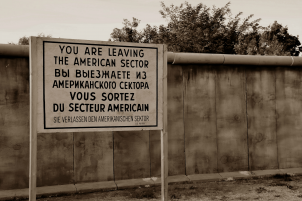When media and communications students learn about the virtues of journalism in a functioning democracy, Woodward and Bernstein are the names that will be etched into their conscience for eternity, but why not Schabowski?
The actions of journalists in both cases resulted in seismic political events that are taught in classrooms around the world, only the former is held up as example to follow for journalism students, whilst the latter in soccer terms is about as close to a metaphorical own goal as you could wish to find.
For those unaware of the names Bob Woodward and Carl Bernstein, as journalists for The Washington Post, they led the way in investigative reporting on the Watergate Scandal, which resulted in the resignation of US President Richard Nixon.
Their actions were portrayed in the 1976 classic All the President’s Men, starring Robert Redford and Dustin Hoffman and serve as tangible recognition of the essential role journalists play holding power to account.
Günter Schabowksi is less well-known, but on the 30th anniversary of the Berlin Wall’s fall, his story is an important one for communications professionals and journalists alike.
Media relations, public affairs, issues and crisis management, change communication – there are lessons for all of us in Schabowski’s complacent lack of preparation, as well as the botched chicanery of the Socialist Unity Party of Germany (Sozialistische Einheitspartei Deutschlands) (SED) leading up to the fateful press conference on November 9th, 1989 – spinning your way out of crisis will eventually send you crashing into a wall.
To set the scene, in the run up to the fall of the Berlin Wall, the SED had been promising liberalising domestic reforms in a bid to ease growing civil unrest.
In 1988, Bruce Springsteen played a live concert in front of 300,000 people in East Berlin. Springsteen famously stopping to deliver a message with powerful resonance, in German: “I’ve come to play rock ‘n’ roll for you in the hope that one day all the barriers will be torn down.”
The SED’s decision to host the concert backfired however; instead of appeasing the public, it became a symbolic moment of hope for the East German people, serving to increase their hunger for more freedom.
In the summer (Northern Hemisphere) of 1989, Austria and Hungary had opened the border between their countries, giving East Germans an escape route – via Czechoslovakia into Hungary, and on into Western Europe.
Back in East Berlin, in Leipzig and other East German towns, protests began to grow in frequency and intensity as did an insatiable appetite for liberty and the right to travel.
In a mendacious ploy to ease the near-revolutionary sentiment running the streets, the SED announced East Germans would be allowed to travel abroad as long as they had a passport. This was done knowing full well the majority would have to apply for one first – a lengthy, bureaucratic process the SED knew it could control.
A press conference was called to make the announcement on the new travel regulations. Schabowski, a former journalist and Party Chief in East Berlin was the man tasked with delivering the message.
The problem was, Schabowski clearly hadn’t prepared, he hadn’t even read the press release in advance. When he gave the statement, he missed the crucial detail about “the requirement of passports” to a conference packed with western journalists, in effect relaying a message that all East Germans were free to travel.
Peter Brinkmann was a reporter for German (then West German) newspaper Bild. Shocked by the proclamation, Brinkmann asked when East Germans could travel, to which Schabowski replied: “Immediately, I suppose.”
The response sent the press conference into meltdown as journalists from around the world peppered the newswires and hammered phone lines to file the biggest story of their careers.
West German TV broadcast the news that night, many East Germans were risking their lives to watch news from the West with regularity by this point, and the report prompted thousands to head to the wall in Berlin, demanding passage to the West.
The border guards could still have opened fire but confused by the statement and overwhelmed by the size of the crowds, the barriers were lowered, setting in motion the fall of the Berlin Wall and the end of the Cold War.
A lack of preparation and message discipline in what should have been a routine press statement inadvertently brought about the end of a 45-year conflict.
Of course, there were numerous other geopolitical developments that played more significant roles in bringing to an end something that had left a dark mist hanging over the world for so long, but there is no doubt Schabowski’s blunder played its part.
Now, 30 years on from this momentous occasion, there are textbook lessons communications professionals and business leaders can absorb.
Brinkmann’s acute question was simple, but the effects were devastating, as a bemused Schabowski fluffed his lines and reduced the SED’s grip and the Berlin Wall to rubble.
For business leaders communicating in high-pressure situations, whether it’s to the media, the public or your employees, being trained, ensuring key messages are prepared in advance and delivered with discipline and having a plan to be ready for issues, are vital to protecting your reputation and ensuring you are not heading into a crisis.
The smallest of communication errors can have disastrous consequences.
But as archive television reels show footage from that iconic moment 30 years ago, most would surely agree Schabowski’s error is one we can celebrate.


